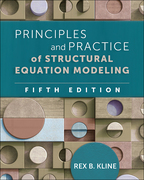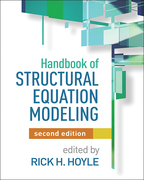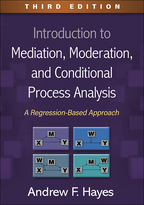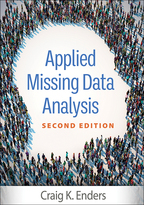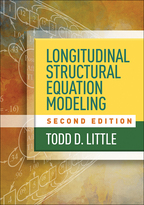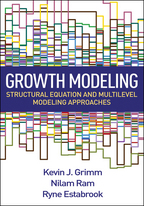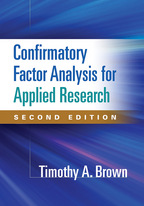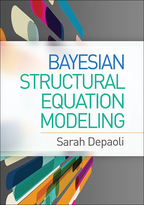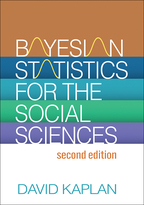Principles and Practice of Structural Equation Modeling
Fifth Edition
Rex B. Kline

- What’s New
- Book Website
- Pedagogical Approach
- Principles > Software
- Symbols and Notation
- Enjoy the Ride
- Plan of the Book
I. Concepts, Standards, and Tools
1. Promise and Problems
- Preparing to Learn SEM
- Definition of SEM
- Basic Data Analyzed in SEM
- Family Matters
- Pedagogy and SEM Families
- Sample Size Requirements
- Big Numbers, Low Quality
- Limits of This Book
- Summary
- Learn More
2. Background Concepts and Self-Test
- Uneven Background Preparation
- Potential Obstacles to Learning about SEM
- Significance Testing
- Measurement and Psychometrics
- Regression Analysis
- Summary
- Self-Test
- Scoring Criteria
3. Steps and Reporting
- Basic Steps
- Optional Steps
- Reporting Standards
- Reporting Example
- Summary
- Learn More
4. Data Preparation
- Forms of Input Data
- Positive Definiteness
- Missing Data
- Classical (Obsolete) Methods for Incomplete Data
- Modern Methods for Incomplete Data
- Other Data Screening Issues
- Summary
- Learn More
- Exercises
- Appendix 4.a. Steps of Multiple Imputation
5. Computer Tools
- Ease of Use, Not Suspension of Judgment
- Human–Computer Interaction
- Tips for SEM Programming
- Ease of Use, Not Suspension of Judgment
- Commercial versus Free Computer Tools
- R Packages for SEM
- Free SEM Software with Graphical User Interfaces
- Commercial SEM Computer Tools
- SEM Resources for Other Computing Environments
- Summary
II. Specification, Estimation, and Testing
6. Nonparametric Causal Models
- Graph Vocabulary and Symbolism
- Contracted Chains and Confounding
- Covariate Selection
- Instrumental Variables
- Conditional Independencies and Other Types of Bias
- Principles for Covariate Selection
- d-Separation and Basis Sets
- Graphical Identification Criteria
- Detailed Example
- Summary
- Learn More
- Exercises
7. Parametric Causal Models
- Model Diagram Symbolism
- Diagrams for Contracted Chains and Assumptions
- Confounding in Parametric Models
- Models with Correlated Causes or Indirect Effects
- Recursive, Nonrecursive, and Partially Recursive Models
- Detailed Example
- Summary
- Learn More
- Exercises
- Appendix 7.a. Advanced Topics in Parametric Models
8. Local Estimation and Piecewise SEM 
- Rationale of Local Estimation
- Piecewise SEM
- Detailed Example
- Summary
- Learn More
- Exercises
9. Global Estimation and Mean Structures
- Simultaneous Methods and Error Propagation
- Maximum Likelihood Estimation
- Default ML
- Analyzing Nonnormal Data
- Robust ML
- FIML for Incomplete Data versus Multiple Imputation
- Alternative Estimators for Continuous Outcomes
- Fitting Models to Correlation Matrices
- Healthy Perspective on Estimators and Global Estimation
- Detailed Example
- Introduction to Mean Structures
- Précis of Global Estimation
- Summary
- Learn More
- Exercises
- Appendix 9.a. Types of Information Matrices and Computer Options
- Appendix 9.b. Casewise ML Methods for Data Missing Not at Random
10. Model Testing and Indexing
- Model Testing
- Model Chi-Square
- Scaled Chi-Squares and Robust Standard Errors for Nonnormal Distributions
- Model Fit Indexing
- RMSEA
- CFI
- SRMR
- Thresholds for Approximate Fit Indexes
- Recommended Approach to Fit Evaluation
- Global Fit Statistics for the Detailed Example
- Power and Precision
- Summary
- Learn More
- Exercises
- Appendix 10.a. Significance Testing Based on the RMSEA
11. Comparing Models
- Nested Models
- Building and Trimming
- Empirical versus Theoretical Respecification
- Chi-Square Difference Test
- Modification Indexes and Related Statistics
- Intelligent Automated Search Strategies
- Model Building for the Detailed Example
- Comparing Nonnested Models
- Equivalent Models
- Coping with Equivalent or Nearly Equivalent Models
- Summary
- Learn More
- Exercises
- Appendix 11.a. Other Types of Model Relations and Tests
12. Comparing Groups
- Issues in Multiple-Group SEM
- Detailed Example for a Path Model of Achievement and Delinquency
- Tests for Conditional Indirect Effects over Groups
- Summary
- Learn More
- Exercises
III. Multiple-Indicator Approximation of Concepts
13. Multiple-Indicator Measurement
- Concepts, Indicators, and Proxies
- Reflective Measurement and Effect Indicators
- Causal–Formative Measurement and Causal Indicators
- Composite Measurement and Composite Indicators
- Mixed-Model Measurement
- Considerations in Selecting a Measurement Model
- Cautions on Formative Measurement
- Summary
14. Confirmatory Factor Analysis
- EFA versus CFA
- Suggestions for Selecting Indicators
- Basic CFA Models
- Other Methods for Scaling Factors
- Detailed Example for a Basic CFA Model of Cognitive Abilities
- Respecification of CFA Models
- Estimation Problems
- Equivalent CFA Models
- Special Tests with Equality Constraints
- Models for Multitrait–Multimethod Data
- Second-Order and Bifactor Models with General Factors
- Summary
- Learn More
- Exercises
- Appendix 14.a. Identification Rules for Correlated Errors or Multiple Loadings
15. Structural Regression Models
- Full SR Models
- Two-Step Modeling
- Other Modeling Strategies
- Detailed Example of Two-Step Modeling in a High-Risk Sample
- Partial SR Models with Single Indicators
- Example for a Partial SR Model
- Summary
- Learn More
- Exercises
16. Composite Models
- Modern Composite Analysis in SEM
- Disambiguation of Terms
- Special Computer Tools
- Motivating Example
- Alternative Composite Model
- Partial Least Squares Path Modeling Algorithm
- PLS PM Analysis of the Composite Model
- Henseler–Ogasawara Specification and ML Analysis
- Summary
- Learn More
- Exercises
IV. Advanced Techniques
17. Analyses in Small Samples
- Suggestions for Analyzing Common Factor Models
- Analysis of a Common Factor Model in a Small Sample
- Controlling Measurement Error in Manifest Variable Path Models
- Adjusted Test Statistics for Small Samples
- Bayesian Methods and Regularized SEM
- Summary
- Learn More
- Exercises
18. Categorical Confirmatory Factor Analysis
- Basic Estimation Options for Categorical Data
- Overview of Continuous/Categorical Variable Methodology
- Latent Response Variables and Thresholds
- Polychoric Correlations
- Measurement Model and Diagram
- Methods to Scale Latent Response Variables
- Estimators, Adjusted Test Statistics, and Robust Standard Errors
- Models with Continuous and Ordinal Indicators
- Detailed Example for Items about Self-Rated Depression
- Other Estimation Options for Categorical CFA
- Item Response Theory and CFA
- Summary
- Learn More
- Exercises
19. Nonrecursive Models with Causal Loops
- Causal Loops
- Assumptions of Causal Loops
- Identification Requirements
- Respecification of Nonrecursive Models That Are Not Identified
- Order Condition and Rank Condition
- Detailed Example for a Nonrecursive Partial SR Model
- Blocked-Error R² for Nonrecursive Models
- Summary
- Learn More
- Exercises
- Appendix 19.a. Evaluation of the Rank Condition
20. Enhanced Mediation Analysis
- Mediation Analysis in Cross-Sectional Designs
- Effect Sizes for Indirect Effects
- Cross-Lag Panel Designs for Mediation
- Conditional Process Analysis
- Causal Mediation Analysis Based on Nonparametric Models and Counterfactuals
- Reporting Standards for Mediation Studies
- Summary
- Learn More
- Exercises
21. Latent Growth Curve Models
- Basic Latent Growth Models
- Data Set for Analyzing Basic Growth Models with No Covariates
- Example Analyses of Basic Growth Models
- Example for a Growth Predictor Model with Time-Invariant Covariates
- Practical Suggestions for Latent Growth Modeling
- Extensions of Latent Growth Models
- Summary
- Learn More
- Exercises
- Appendix 21.a. Unequal Measurement Intervals and Options for Defining the Intercept
22. Measurement Invariance
- Levels of Invariance
- Analysis Decisions
- Partial Measurement Invariance
- Detailed Example for a Two-Factor Model of Divergent Thinking
- Practical Suggestions for Measurement Invariance Testing
- Measurement Invariance Testing in Categorical CFA
- Other Statistical Approaches to Estimating Measurement Invariance
- Summary
- Exercises
23. Best Practices in SEM
- Resources
- Bottom Lines and Statistical Beauty
- Mightily Distinguish Your Work (Be a Hero)
- Family Relations
- Specification
- Identification
- Measures
- Sample and Data
- Estimation
- Respecification
- Tabulation
- Interpretation
- Summary
- Learn More
Suggested Answers to Exercises
References
Author Index
Subject Index
About the Author

